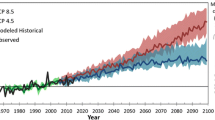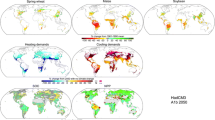Abstract
The issue of the distillation of actionable climate change information for application to vulnerability, impacts and adaptation studies in support of climate service activities (or VIA-CS) at regional to local scales is revisited. The 3R approach is introduced: robustness, reliability and relevance. Climate information for regions needs to be robust in the sense of producing statistically significant and consistent change signals based on multimodel and multimethod ensembles; it needs to be reliable in the sense of being based on a good understanding of the physical processes underlying the change signals, and on models capable of reproducing the functioning of the climate system at different scales; it needs to be relevant in the sense of providing information targeted for use in VIA-CS applications, including a proper characterization of uncertainties based on probabilistic approaches. It is advocated that the distillation problem requires an interdisciplinary consensus approach and a new generation of scientists acting at the interface between the climate modelling and end-user communities.





Similar content being viewed by others
References
R. Buizza, M. Leutbecher, The forecast skill horizon. Q. J. R. Meteorol. Soc. (2015). https://doi.org/10.1002/qj.2619
E.K.M. Chang, Y. Guo, X. Xia, CMIP5 multimodel ensemble projection of storm track change under global warming. J. Geophys. Res. 117, D23118 (2012). https://doi.org/10.1029/2012JD018578
M. Chen et al., Assessing objective techniques for gauge-based analyses of global daily precipitation. J. Geophys. Res. 113, D04110 (2008)
E. Coppola et al., A first-of-its-kind multi-model convection permitting ensemble for investigating convective phenomena over Europe and the Mediterranean. Clim. Dyn. 1, 2 (2019). https://doi.org/10.1007/s00382-018-4521-8
M. Deque et al., An intercomparison of regional climate simulations for Europe. Assessing uncertainties in model projections. Clim. Change 81, 53–70 (2007)
V. Eyring et al., Overview of the coupled model intercomparison project phase 6 (CMIP6) experimental design and organization. Geosci. Model. Dev. 9, 1937–1958 (2016)
G. Flato et al., Evaluation of climate models, in Climate change 2013: the physical science basis. Contribution of working group I to the fifth assessment report of the intergovernmental panel on climate change (IPCC), ed by T.F. Stocker, et al. (Cambridge University Press, Cambridge, U.K., 2013), pp. 741–866
X.J. Gao, J.S. Pal, F. Giorgi, Projected changes in mean and extreme precipitation over the Mediterranean region from a high resolution double nested RCM simulations. Geophys. Res. Lett. 33, L03706 (2006)
N.P. Gillett, Weighting climate model projections using observational constraints. Phil. Trans. R. Soc. A 373, 20140425 (2015). https://doi.org/10.1098/rsta.2014.0425
F. Giorgi, Dependence of surface climate interannual variability on spatial scale. Geophys. Res. Lett. 29, 2101 (2002)
F. Giorgi, Climate change prediction. Clim. Change 73, 239–265 (2005)
F. Giorgi, Thirty years of regional climate modeling: where are we and where are we going next? J. Geophys. Res. Atmos. 124, 5696–5723 (2019)
F. Giorgi, L.O. Mearns, Approaches to the simulation of regional climate change: a review. Rev. Geophys. 29, 191–216 (1991)
F. Giorgi, L.O. Mearns, Calculation of average, uncertainty range and reliability of regional climate changes from AOGCM simulations via the “reliability ensemble averaging (REA)” method. J. Clim. 15, 1141–1158 (2002)
F. Giorgi, E. Coppola, European climate change oscillation (ECO). Geophys. Res. Lett. (2007). https://doi.org/10.1029/2007GL031223
F. Giorgi, P. Lionello, Climate change projections for the Mediterranean region. Glob. Planet. Change 63, 90–104 (2008)
F. Giorgi et al., Emerging patterns of simulated regional climatic changes for the 21st century due to anthropogenic forcings. Geophys. Res. Lett. 28, 3317–3320 (2001)
F. Giorgi, W.L. Gutowski, Regional dynamical downscaling and the CORDEX initiative. Ann. Rev. Environ. Res. 40, 467–490 (2015)
F. Giorgi, J.W. Hurrell, M.R. Marinucci, M. Beniston, Elevation dependency of the surface climate change signal. J. Clim. 10, 288–296 (1997)
F. Giorgi, C. Jones, G. Asrar, Addressing climate information needs at the regional level: the CORDEX framework. WMO Bull. 58, 175–183 (2009)
F. Giorgi et al., Enhanced summer convective rainfall at Alpine high elevations in response to climate warming. Nat. Geosci. 9, 584–589 (2016)
W.J. Gutowski et al., WCRP coordinated regional downscaling experiment (CORDEX): a diagnostic MIP to CMIP6. Geosci. Model Dev. 9, 4087–4095 (2016)
I. Harris, P.D. Jones, T.J. Osborn, D.H. Lister, Updated high resolution grids of monthly climatic observations—the CRU TS3.10 dataset. Int. J. Climatol. (2013). https://doi.org/10.1002/joc.3711
E. Hawkins, R. Sutton, The potential to narrow uncertainty in regional climate projections. Bull. Am. Meteorol. Soc. 90, 1095–1107 (2009)
B.C. Hewitson, R.G. Crane, Climate downscaling: techniques and applications. Clim. Res. 7, 85–95 (1996)
B.C. Hewitson, J. Daron, R.G. Crane, M.F. Zermoglio, C. Jack, Interrogating empirical-statistical downscaling. Clim. Change 122, 539–554 (2014)
B.C. Hewitson, K. Waagsaether, J. Wohland, K. Kloppers, T. Kara, Climate information websites: an evolving landscape. WIREs Clim. Change 8, e470 (2017). https://doi.org/10.1002/wcc.470
Intergovernmental Panel on Climate Change (IPCC), The physical science basis. Contribution of working group I to the fifth assessment report of the intergovernmental panel on climate change (IPCC), ed by T.F. Stocker, et al. (Cambridge University Press, Cambridge, U.K., 2013), pp. 741–866
F.A. Isotta et al., The climate of daily precipitation in the Alps: development and analysis of a high-resolution grid dataset from pan-Alpine rain-gauge data. Int. J. Climatol. 34, 1657–1675 (2014)
D. Jacob et al., EURO-CORDEX: new high-resolution climate change projections for European impact research. Reg. Environ. Change 14, 563–578 (2013)
R. Knutti, The end of model democracy? An editorial comment. Clim. Change 102, 395–404 (2010)
R. Knutti et al., A climate model projection weighting scheme accounting for performance and independence. Geophys. Res. Lett. 44, 1909–1918 (2017)
R. Laprise, Regional climate modeling. J. Comput. Phys. 227, 3641–3666 (2008)
D.R. Legates, C.J. Willmott, mean seasonal and spatial variability in gauge-corrected global precipitation. Int. J. Climatol. 10, 111–127 (1990)
E.N. Lorenz, On the existence of extended range predictability. J. Appl. Meteorol. 12, 543–546 (1973)
N. Massey et al., Weather@home - development and validation of a very large ensemble modeling system for probabilistic event attribution. Q. J. R. Meteorol. Soc. 141, 1528–1545 (2015)
L.O. Mearns, I. Bogardi, F. Giorgi, I. Matyakovszky, M. Pilecki, Comparison of climate change scenarios generated from regional climate model experiments and statistical downscaling. J. Geophys. Res. 104, 6603–6621 (1999)
L.O. Mearns et al., Guideline for use of climate scenarios developed from regional climate model experiments. Report of the Data Distribution Center (DDC) of the IPCC (2003), 38 p
G.A. Meehl et al., Decadal climate prediction. An update from the trenches. Bull. Am. Meteorol. Soc. (2014). https://doi.org/10.1175/BAMS-D-12-00241.1
R.H. Moss et al., The next generation of scenarios for climate change research and assessment. Nature 463, 747–756 (2010)
B.C. O’Neill et al., A new scenario framework for climate change research: the concept of shared socio-economic pathways. Clim. Change 122, 387–400 (2014)
B. Onol, Effects of coastal topography on climate: high resolution simulation with a regional climate model. Clim. Res. 52, 152–174 (2013)
T.N. Palmer, F.J. Doblas-Reyes, A. Weisheimer, M.J. Rodwell, Towards seemless prediction: calibration of climate change projections using seasonal forecasts. Bull. Am. Meteorol. Soc. 89, 459–470 (2008)
H. Paeth et al., Progress in regional downscaling of West Africa precipitation. Atmos. Sci. Lett. 12, 75–82 (2011)
N. Pepin et al., Elevation-dependent warming in mountain regions of the World. Nat. Clim. Change 5, 424–430 (2015)
A.F. Prein, A. Gobiet, Impacts of uncertainties in European gridded precipitation observations on regional climate analysis. Int. J. Climatol. 37, 305–327 (2017)
A.F. Prein et al., A review on regional convection permitting regional climate modeling: demonstrations, prospects and challenges. Rev. Geophys. 53, 323–361 (2015)
C. Piani, J.O. Haerter, E. Coppola, Statistical bias correction for daily precipitation in regional climate models over Europe. Theor. Appl. Climatol. 99, 187–192 (2010)
M. Rummukainen, State-of-the-art with regional climate models. WIREs Clim Change 1, 82–96 (2010)
K.T. Taylor, R.J. Stouffer, G.E. Meehl, An overview of CMIP5 and experiment design. Bull. Am. Meteorol. Soc. 93, 485–498 (2012)
C. Tebaldi, J.M. Arblaster, Pattern scaling: its strengths and limitations, and an update on the latest model simulations. Clim. Change 122, 459–471 (2014)
C. Teutschbein, J. Seibert, Bias correction of regional climate model simulations for hydrological climate change impact studies: review and evaluation of different methods. J. Hydrol. 456–457, 12–29 (2012)
S.W. Yeh et al., ENSO atmospheric teleconnections and their response to greenhouse gas forcing. Rev. Geophys. 56, 185–206 (2018)
I.G. Watterson, Calculation of probability density functions for temperature and precipitation change under global warming. J. Geophys. Res. Atmos 113, D12106 (2008). https://doi.org/10.1029/2007jd009254
R.L. Wilby et al., Statistical downscaling of general circulation model output: a comparison of methods. Water Res. Res. 34, 2995–3008 (1998)
R.L. Wilby et al., Guidelines for use of climate scenarios developed from statistical downscaling methods. Report of the Data Distribution Center (DDC) of the IPCC (2004), 27 p
J.W. Williams, S.T. Jackson, J.E. Kutzbach, Projected distributions of novel and disappearing climates by 2100 AD. Proc. Natl. Acad. Sci. U.S.A. 104, 5738–5742 (2007)
G. Zappa, T.G. Shepherd, Storylines of atmospheric circulation change for European regional climate impact assessment. J. Clim. 30, 6561–6577 (2017)
Acknowledgements
I would like to thank F. Raffaele for help in producing some of the figures in this paper. The data used in this work can be found in the following websites: http://cmip-pcmdi.llnl.gov/cmip5/data_portal.html (CMIP5).
Author information
Authors and Affiliations
Corresponding author
Rights and permissions
About this article
Cite this article
Giorgi, F. Producing actionable climate change information for regions: the distillation paradigm and the 3R framework. Eur. Phys. J. Plus 135, 435 (2020). https://doi.org/10.1140/epjp/s13360-020-00453-1
Received:
Accepted:
Published:
DOI: https://doi.org/10.1140/epjp/s13360-020-00453-1




